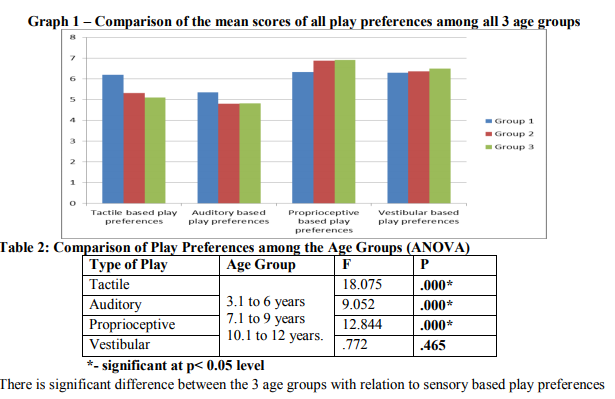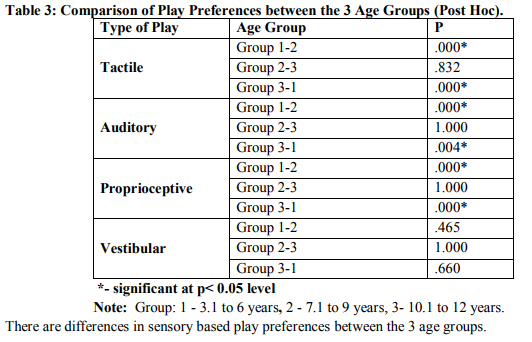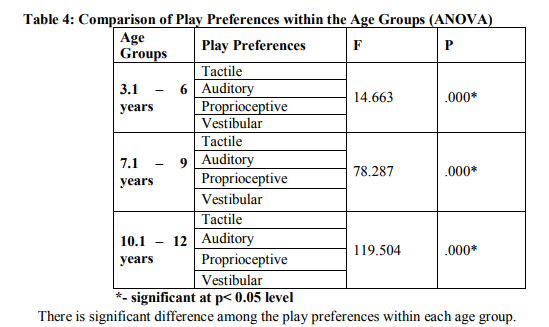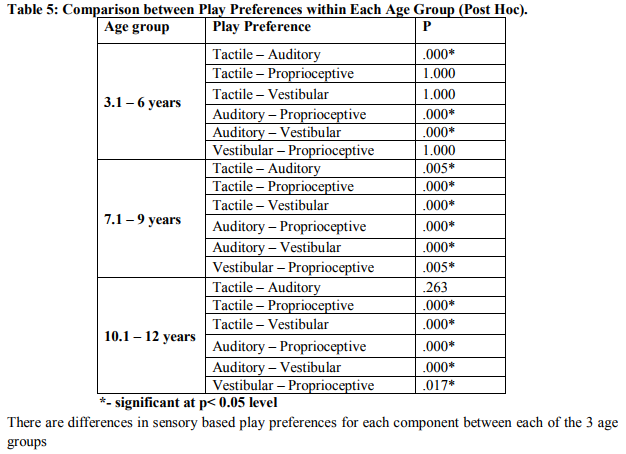IJCRR - 4(17), September, 2012
Pages: 23-30
Date of Publication: 14-Sep-2012
Print Article
Download XML Download PDF
AN OBSERVATIONAL STUDY ON SENSORY BASED OUTDOOR PLAY PREFERENCES IN CHILDREN AGED BETWEEN 3 - 12 YEARS : A PRELIMINARY STUDY
Author: KR. Banumathe, Vineeta .I. Ram, Alzeena Pinto, Samuel Jonathan
Category: Healthcare
Abstract:Aim: To find sensory based outdoor play preferences of children between the ages 3 -12 years. Method: 90 normal children were observed by 3 raters for 30 minutes minimum, while engaged in free play at outdoor playgrounds. Play preferences were observed for the affinity towards certain sensory components; tactile, auditory, vestibular and proprioception. The most observable sensory based play preferences were noted for quality and frequency and the children were scored on a 7 point Likert scale. The data was then grouped by age into 3 groups, 1, 2 and 3; 3.1 to 6 years, 7.1 to 9 years and 10.1 to 12 years respectively and analyzed using SPSS, version 16. Results: On analysis of data between the groups showed that there was significant difference at p< 0.05 levels for tactile, auditory and proprioceptive except vestibular based play preferences at p>0.05 levels. Auditory based play preferences showed a significant difference at p< 0.05 level to other preferences for group 1. Group 2 showed significant difference between all sensory based play preferences at p< 0.05 levels and for group 3, no significant difference between auditory and tactile based play preferences at p>0.05 levels and significant difference between the rest of the components at p< 0.05 levels. It also inferred tactile and auditory based play preferences decrease while proprioceptive and vestibular based play preferences increase with the increase in age. Conclusion: These findings proved that sensory based outdoor play
preferences of children exist and differ between the ages 3 to 12 years.
Keywords: Play preferences, Sensory Based Play, Outdoor Play Preferences
Full Text:
INTRODUCTION
Play is a child?s primary and most important occupation1 .It has historically been regarded by occupational therapists as both an indicator of development and a means of intervention2 . Many occupational therapists feel that the common themes in play include intrinsic motivation, internal reality, and internal locus of control, are needed for a child to engage in playful behaviors and interactions. When these are present, a child is self-motivated to engage in a play activity, is free fromData Analysis rules, procedures or guidelines to follow during the play, and is able to self-direct play3 . If a child has a deficit in his or her ability to be intrinsically motivated, to suspend reality, to have an internal locus of control, to be happy, energetic or playful, or has an inability to process sensory information from play experiences, then a child?s development may be stifled4 . Taking this into consideration, how children make play choices and assign meaning to the experience of this occupation is an important area of study for occupational therapists, to better understand this occupation and the use of play within practice5 . Significant research has been accumulated on play preference with regard to gender and age; less research exists on the relation of play preferences to the ability4 .Research on the meaning of play for children or on children?s perspective and rationale for their play choices remains scarce6 . A study on Children?s perceptions of play experiences and the development of play preferences, found that it would be beneficial for therapists to understand the long-term implications of play choices in children and their impact on development over time. Also suggested the relationship between a children?s sensory processing and his or her specific play choices could be an important area for further study4 . Based on this, and related literature, this preliminary study was undertaken to further understand, explore and describe the relationship between sensory processing and play preferences which in turn will improve the use of play in pediatrics evaluation and intervention with the following research question: Do children between the ages 3 and 12 years have sensory based play preferences.
Aim
The aim of this study is to find sensory based outdoor play preferences of children between 3 and 12 years of age.
Objectives
- To observe children between 3 -12 years playing in an outdoor playground.
- To identify the sensory based play preferences among these children.
Research Hypothesis
Null Hypothesis
There will not be any significant difference in sensory based play preferences for children between the ages 3 and12.
Methodology
Pilot Study
A pilot study was conducted initially to check if sensory based play preferences are present and can be assessed. It is also to assess the reliability of scores of the three raters. This was done by each rater observing the same five children individually in an open playground with common play equipment such as swings, slides; see saw, monkey bars, the merry go round and sand pits for duration of 30 minutes each. Observations were noted by the 3 raters separately and were scored using the 7 point Likert scale.
Inclusion Criteria
Normal children of both boys and girls aged between 3 to 12 years.
Exclusion Criteria
- Children with any physical or mental disability.
- Children who played for less than 30 minutes.
Setting
Two outdoor playgrounds with similar types of play equipment such as slides, swings, see-saw, monkey bars, sand pits and merry go rounds.
Sample Size
Study Design
Tool
Scoring Criteria
Procedure
- Children who came with their parents were selected randomly for the study; oral consent was taken prior to the study from the children?s parents along with the child's details demographic, physical and mental health.
- Three investigators directly observe the spontaneous play of an individual child in a playground for 30 minutes minimum from a suitable vantage point with the children being unaware of the observers.
- Using the 7- point Likert scale as the tool of measure, each observer evaluated the same individual child independently using the definitions mentioned before in the Operational definitions as a reference.
- The average of each observer?s score for each variable was taken following which the data was analyzed.
Data Analysis
The results were analyzed at p<0.05 level of significance. Using SPSS version 16, the following tests such as Descriptive analysis in order to summarize the data and compute means and standard deviations, ANOVA to compare the means of play preferences among the age group and within the age group, POST HOC to analyze which type of play preference is significantly difference among the age group and within the age group was used.
Results
As mentioned in the procedure, sensory based play preferences were observed for normal children for the affinity towards certain sensory components such as Tactile, Auditory, Vestibular and Proprioception. These components were observed and noted for the type of play they engaged in, the time period for which they took part in such, and joy manifestation. The most observable sensory based behaviors were noted and the quality and frequency at which they occurred. Based on these factors, the raters scored the children using Likert?s scale. Three raters examined and grouped the data under three groups 1,2 and 3 according to age, 3.1 to 6, 7.1 to 9 and 10.1 to 12 years respectively and calculated the mean for each sample which was rounded off to the nearest whole number, the and the results were then analyzed as follows:
Tactile based play preferences between the 3 age groups
For tactile based play preferences, the mean scores obtained were 6.1892, ±.84452 for group 1, 5.322, ±.79108 for group 2 and 5.0909, ±.52636, for group 3. The mean difference obtained with the group was tested for significance using ANOVA and the „F? score 18.075 which was significant at p< 0.05 levels. The Post HOC further revealed a significant difference between the groups 1 and 2 and groups 1 and 3 at p0.05 levels when the groups 2 and 3 were compared.
Auditory based play preferences between the 3 age groups
For auditory based play preferences, the mean scores obtained were 5.3514, ± .75337 for group1, 4.8065, ±.47745 for group 2 and, 4.8182, ±.39477, for group 3. The mean difference obtained with the group was tested for significance using ANOVA and the „F? score 9.052 which was significant at p0.05 levels when the groups 2 and 3 were compared.
Proprioceptive based play preferences between the 3 age groups
For proprioceptive based play preferences, the mean scores obtained were 6.3243, ± .70923 for group1, 6.8710, ±.34078 for group 2 and, 4.8182, ±.39477, for group 3. The mean difference obtained with the group was tested for significance using ANOVA and the „F? score 12.844 which was significant at p0.05 levels when the groups 2 and 3 were compared.
Vestibular based play preferences between the 3 age groups
For vestibular based play preferences, the mean scores obtained were 6.2973, ± .61756 for group1, 6.3548, ±.66073 for group 2 and, 6.5000, ±.51177 for group 3. The mean difference obtained with the group was tested for significance using ANOVA and the „F? score .772 which was not significant at p>0.05 levels. The Post HOC revealed no significant difference between the groups 1 and 2 and 3 at p>0.05 levels.
Play preferences within group 1
The mean scores obtained for tactile based play preferences 6.1892,±.84452,auditory based play preferences 5.3514,±.75337,proprioceptive based play 6.3243,.70923 and vestibular based play preferences 6.2937,.61756.We used ANOVA to find the significant difference between these mean values, with the „F? score being 14.663,we found that they were significantly different at the p0.05 levels.
Play preferences within group 2
The mean scores obtained for tactile based play preferences5.3226,±.79108,auditory based play preferences 4.8065,±.47745,proprioceptive based play 6.8710,.34078 and vestibular based play preferences 6.3548,±.66073.We used ANOVA to find the significant difference between these mean values, with the „F? score being 72.287,we found that they were significantly different at p<0.05 levels. On further analysis using the Post HOC shows a significant difference between all sensory based play preferences considered at p<0.05 levels.
Play preferences within group 3
The mean scores obtained for tactile based play preferences 5.0909,±.52636,auditory based play preferences 4.8182,±.39477,proprioceptive based play 6.9091,.±29424 and vestibular based play preferences 6.5000,±.51177.We used ANOVA to find the significant difference between these mean values, with the „F? score being 119.504,we found that they were significantly different at P0.05 levels however there is a significant difference between the rest of the components at P<0.05 levels.
Discussion
The purpose of our study was to better understand play and play preferences and as a preliminary study to assess the feasibility of studying sensory based play preferences. From these results we may infer that play preferences may be sensory based in children between the ages 3-12 years. This clearly answers our research question and satisfies our aim and objectives as mentioned before. Our inference that sensory based play preferences change with age may be further supported by these statements „Outdoor play preferences have been shown to change with age?, as reported by Scarlett et al., 2005 and „Children?s play preferences are influenced by age and developmental status? as found by Case Smith and Kuhaneck, 2008 in their studies. We observed that tactile and auditory based play preferences decrease with the increase in age, while proprioceptive and vestibular based play preferences increase with the increase in age. We also had the opportunity to observe free play and the changes that influence play in terms of social, cognitive and physical components with regard to age and development.
As mentioned in the literature review supported by statements from Morrison CD et al., 2001 and Bundy AC, 2002, we chose to observe free play in order to proceed with our study with regard to common themes in play, which included intrinsic motivation. While we believe these statements hold true, we also feel, on observation that we must also consider other influences such as social influences that may motivate children to engage in play, especially in older children. As this was a preliminary study, we feel there is a further need to explore this area using more standardized methods.
Implications
The implications of this study are threefold; 1. Our results show play preferences may be sensory based. 2. The results may support giving sensory based play across the ages according to the found age group preferences in clinical practice in order to increase the quality of play as therapy, by increasing intrinsic motivation and the internal locus of control and as Ayers suggested, to support children enhance their development through active exploration of the environment and receiving various sensory inputs through manipulation of materials. 3. As this study was a preliminary one, and our results support our research question. This study may be used as a baseline or guide for further studies in this important area.
Limitations and Recommendations
As this study is a preliminary study, the results open a broad window for future studies to give a better perspective on the relationship between sensory based play preferences of children with regard to their developmental age. Population for the study was taken only based on the parental information and no standardized screening tool was used. For future studies, more standardized screening tool can be used. The sample size was small, and was restricted to Manipal area alone, so further studies can be considered by including other different regions. The raters for this study were not blinded and the unavailability of an expert in the field of observation which could influence the study results. Prospective studies in this field can improvise on the above mentioned limitations. If the play behavior was videotaped and assessed it would have been more standardized. Time constraints on the children playing may also influence the nature of the play in turn influence the inclusion of the subject and quality of play. This can be considered for future research as it will influence the study results. Further study can be focused on indoor play preferences as it is feasible for practice in indoor based clinical settings.
Conclusion
From the outcome of this study, we can reject the null hypothesis. The results have proved that there is a significant difference in the sensory based outdoor play preferences of children between the ages 3 to 12 years. The tactile and auditory based play preferences decrease with the increase in age, while proprioceptive and vestibular based play preferences increase with the increase in age. This implies the need for considering the play preferences in clinical practice to improve the quality of play as therapy.
Acknowledgements
We would like to take this opportunity to offer our sincere gratitude to Mr. Shovan Saha, HOD and Mr. Shashidhar Rao, Dept. of Occupational Therapy, & Mr. Hari Prakash, Dept. of Speech & Hearing, Manipal for their constant support and encouragement. Authors acknowledge the immense help received from the scholars whose articles are cited and included in references of this manuscript. The authors are also grateful to authors/editors/publishers of all those articles, journals and books from where the literature for this article has been reviewed and discussed.
References:
1. Bundy AC. Play Theory and Sensory Integration. In: Bundy AC, Lane SJ, Murray EA editors. Sensory Integration Theory and Practice. 2nd ed. Philadelphia: FA Davis; 2002. p. 227-40.
2. Parham L, Primeau L. Play and occupational therapy. In: Parham LD, Fazio L, editors. Play in occupational therapy for children. St. Louis: Mosby; 1997. p. 02–21.
3. Morrison CD, Metzger P. Play. In: Schrefer J, White K, Mosby L, editors. Occupational Therapy for Children. 4th ed. St. Louis: Mosby; 2001. p.528-40.
4. Miller E, Kuhaneck H. Children?s perceptions of play experiences and the development of play preferences: A qualitative study. American Journal of Occupational Therapy 2008; 62:407-15.
5. Couch KJ, Deitz JC, Kanny EM. The role of play in pediatric Occupational therapy. Am J of Occupational Therapy1998; 52: 111–17.
6. Smith CJ, Kuhaneck H. Play preferences of typically developing children and children with developmental delays between the ages 3 and 7 years. Occupational Therapy J of Research 2008; 1:19-20.





|






 This work is licensed under a Creative Commons Attribution-NonCommercial 4.0 International License
This work is licensed under a Creative Commons Attribution-NonCommercial 4.0 International License